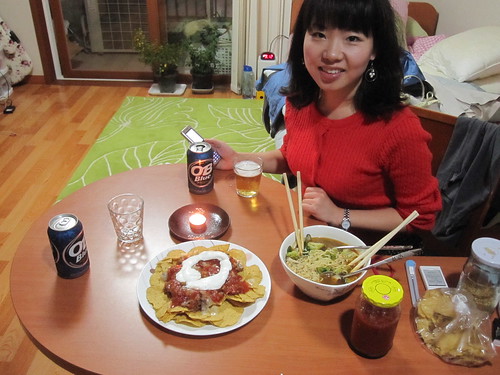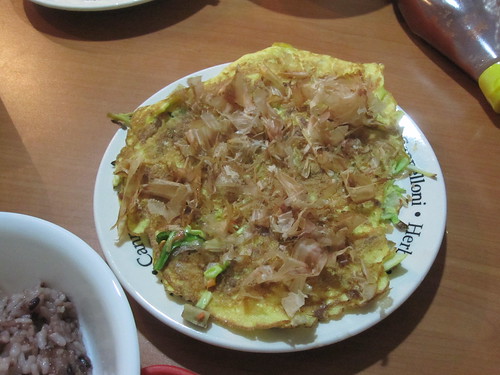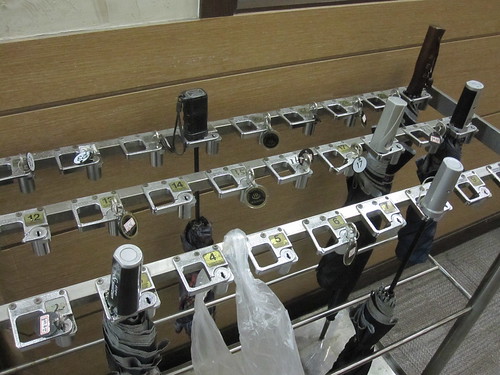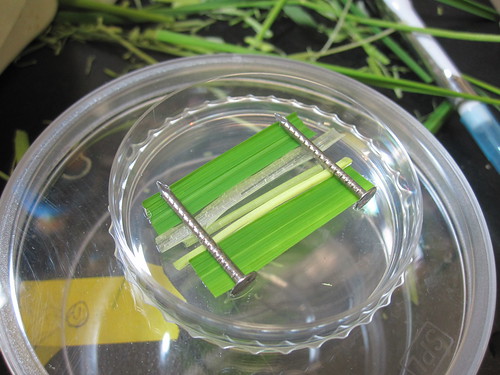Yulim invited us to a Christmas Eve pot-luck party, which we were going to go to. So at around 7pm I made some nachos for us to bring, but we later found out that we wouldn't be starting until 10:30pm. So Heather and I stared at the nachos for a while and then decided it best to have our own 2 person Eve party at home.
How do you turn a plate of nachos into a party for two? Open 2 cans of beer and cook some ramyeon.

The party started off a little quietly with just some nibbling of corn chips and sour cream. By the time we got to the ramyeon though, the party was in full swing with Heather's Gomplayer playlist on in the background and me entertaining the both of us with my anecdotes of life in Korea.

Heather has been doing a bit more cooking lately and is starting to develop her own signature style, which I have termed 'Conglomerative Cooking'. In the photo above is a fusion dish she made, which is a mixture of Korean pajeon and Japanese okonomiyaki.
It was pretty good.

This is a locker rack for personal umbrellas at our local mogyoktang. Korea in general doesn't have much of a thievery problem compared to Australia, but on occasion I have had my umbrella 'unwittingly borrowed' from a restaurant collection bin.

Jae-Eun from Sejong University recently bought some Kopi Luwak and let me try some. This is a special kind of coffee that is found in the faeces of the palm civet. Civets eat the ripest berries, and their digestive tract also changes the flavour of the coffee. Roboseyo recently tried it also. In Australia, it sells for AU$50 per cup.
It tastes not so different from normal coffee, but quite rich and a little bitter. Worth a try, but only so that you can say you have.

One thing we're trying these days is an experiment involving rice leaves. But for it to work, the leaves need to lay flat on some clear gel, which they don't like to do. Rakshya and I had a makeshift idea to use the weight of nails to pin them down.
It works.

And here are my tobacco plants, looking a little unhappy after an agrobacterium infiltration. In this experiment, we use a needleless syringe to inject bacteria into the spaces between leaf cells. The bacteria multiply in the spaces and do some useful work for us in there.
These days in the laboratory, work is piling up. Science is all about reliable results, which are hard to come by. My success rate so far is about 20%, which is pretty average. It's all about figuring out what went wrong and improving on the technique. At times I feel like a molecular Sherlock Holmes, but not as smart or exciting.
How do you turn a plate of nachos into a party for two? Open 2 cans of beer and cook some ramyeon.

The party started off a little quietly with just some nibbling of corn chips and sour cream. By the time we got to the ramyeon though, the party was in full swing with Heather's Gomplayer playlist on in the background and me entertaining the both of us with my anecdotes of life in Korea.

Heather has been doing a bit more cooking lately and is starting to develop her own signature style, which I have termed 'Conglomerative Cooking'. In the photo above is a fusion dish she made, which is a mixture of Korean pajeon and Japanese okonomiyaki.
It was pretty good.

This is a locker rack for personal umbrellas at our local mogyoktang. Korea in general doesn't have much of a thievery problem compared to Australia, but on occasion I have had my umbrella 'unwittingly borrowed' from a restaurant collection bin.

Jae-Eun from Sejong University recently bought some Kopi Luwak and let me try some. This is a special kind of coffee that is found in the faeces of the palm civet. Civets eat the ripest berries, and their digestive tract also changes the flavour of the coffee. Roboseyo recently tried it also. In Australia, it sells for AU$50 per cup.
It tastes not so different from normal coffee, but quite rich and a little bitter. Worth a try, but only so that you can say you have.

One thing we're trying these days is an experiment involving rice leaves. But for it to work, the leaves need to lay flat on some clear gel, which they don't like to do. Rakshya and I had a makeshift idea to use the weight of nails to pin them down.
It works.

And here are my tobacco plants, looking a little unhappy after an agrobacterium infiltration. In this experiment, we use a needleless syringe to inject bacteria into the spaces between leaf cells. The bacteria multiply in the spaces and do some useful work for us in there.
These days in the laboratory, work is piling up. Science is all about reliable results, which are hard to come by. My success rate so far is about 20%, which is pretty average. It's all about figuring out what went wrong and improving on the technique. At times I feel like a molecular Sherlock Holmes, but not as smart or exciting.


Recent comments